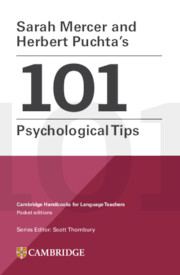Book contents
- Frontmatter
- Contents
- Acknowledgements
- Why We Wrote This Book
- A Psychological Tips for Teacher Wellbeing
- B Psychological Tips for Leading With Compassion, Authority and Skill
- C Psychological Tips for the Socio-Emotional Climate of the Group
- D Psychological Tips for Learner Engagement
- E Psychological Tips for Learner Self-Esteem
- F Psychological tips for Empowering Learners
- Index
C - Psychological Tips for the Socio-Emotional Climate of the Group
Published online by Cambridge University Press: 12 October 2023
- Frontmatter
- Contents
- Acknowledgements
- Why We Wrote This Book
- A Psychological Tips for Teacher Wellbeing
- B Psychological Tips for Leading With Compassion, Authority and Skill
- C Psychological Tips for the Socio-Emotional Climate of the Group
- D Psychological Tips for Learner Engagement
- E Psychological Tips for Learner Self-Esteem
- F Psychological tips for Empowering Learners
- Index
Summary
The socio-emotional climate emerges from the quality of the social relationships in the class and the kinds of emotions typically experienced by the learners in the group. It is facilitative for learning when learners feel safe, welcome and accepted in their individuality within the class, not only in respect to their teachers but, most importantly, by their peers.
43 Use us/we instead of me/you
44 Use restorative practices
45 Insist on politeness
46 Share something personal about yourself
47 Regularly take the group temperature
48 Share your enthusiasm
49 Be thoughtful about eye contact
50 Include tasks that promote kindness
51 Be aware of your emotional expression
52 Integrate tasks which require learner interdependence
53 Help students make responsible decisions
54 Diversify representation in your materials
55 Integrate whole group rapport rituals
56 Use ice-breakers repeatedly
57 Engage students in taking and switching perspectives
58 Use grading scales to establish trust
59 Use selfie wallcharts
43 Use us/we instead of me/you
The language teachers use can impact the sense of community and shared group identity.
Language ‘creates realities and invites identities’ (Johnston, 2004, p. 9). Teachers are often the key source of target language for learners serving as models of language use. However, teacher language also impacts on the positionings of learners and teachers in relation to one another in how they talk, the words used and patterns of interaction employed.
Compare the relationship and power dynamics implied by a teacher who says: You have to work on this task now before you can go to a break with: Why don't we finish up this task now so we can relax and enjoy the break afterwards?
Teacher language can create perceptions of work/fun, obligation/ choice and learning/knowing, among others. In this tip, we focus on the potential strengthening of group identity and sense of community when teachers use us and we, instead of me and you. Obviously, sometimes the distinction remains relevant and necessary – you may wish to stress something is their choice; however, there are many instances where teachers can express solidarity and implied shared investment in learning goals. Naturally, such language use should mirror teacher actions, and students need to feel its use is authentic and welcome such a connection with the teacher.
- Type
- Chapter
- Information
- Sarah Mercer and Herbert Puchta's 101 Psychological Tips , pp. 45 - 62Publisher: Cambridge University PressPrint publication year: 2023



